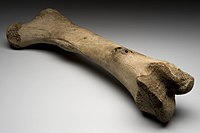
Photo from wikipedia
The ability to enhance fracture healing is paramount in modern orthopaedic trauma, particularly in the management of challenging cases including peri-prosthetic fractures, non-union and acute bone loss. Materials utilised in… Click to show full abstract
The ability to enhance fracture healing is paramount in modern orthopaedic trauma, particularly in the management of challenging cases including peri-prosthetic fractures, non-union and acute bone loss. Materials utilised in enhancing fracture healing should ideally be osteogenic, osteoinductive, osteoconductive, and facilitate vascular in-growth. Autologous bone graft remains the gold standard, providing all of these qualities. Limitations to this technique include low graft volume and donor site morbidity, with alternative techniques including the use of allograft or xenograft. Artificial scaffolds can provide an osteoconductive construct, however fail to provide an osteoinductive stimulus, and frequently have poor mechanical properties. Recombinant bone morphogenetic proteins can provide an osteoinductive stimulus; however, their licencing is limited and larger studies are required to clarify their role. For recalcitricant non-unions or high-risk cases, the use of composite graft combining the above techniques provides the highest chances of successfully achieving bony union.
Journal Title: EFORT Open Reviews
Year Published: 2023
Link to full text (if available)
Share on Social Media: Sign Up to like & get
recommendations!